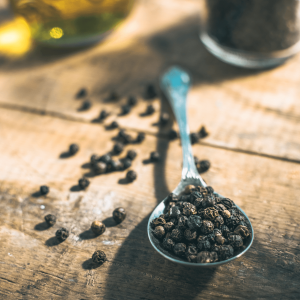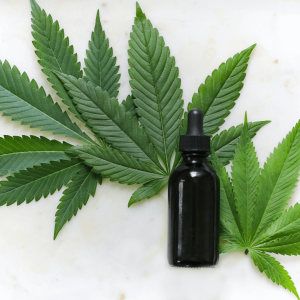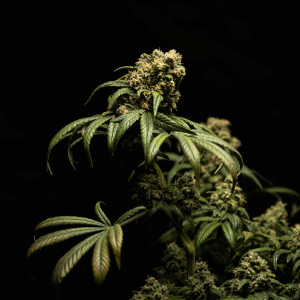Did you wake up this morning and think, “I need more caryophyllene terpene in my life.” No? Well, your body begs to differ.
Let’s talk terpenes, those often overlooked compounds that make the world of botanical aromatics go round. They’re the unsung heroes giving pine trees their signature scent, citrus its zesty punch, and cannabis its signature scent.
Now, meet beta-caryophyllene, the terpene that’s out here doing the heavy lifting in the spice department… and your weed stash. It’s the secret agent in black pepper, delivering that robust, spicy kick. It’s also found casually chilling in cloves, hops, cinnamon, and you guessed it — cannabis.
So, when you’re savoring that spicy, woody aroma of your favorite strain, take a moment to thank caryophyllene terpene for spicing up your life!
In this blog, we’re discussing everything you need to know about the caryophyllene terpene. So whether you’re an OG stoner or a curious newbie, keep reading for all the details.
What are Terpenes?
Okay, so let’s break down the basics: what are terpenes anyway? Put simply, they’re the aromatic oils that plants produce to lure pollinators and deter pests, but for us humans, they provide all the tasty flavors and scents we know and love. They’re why lemons have that zing, why pine forests smell so fresh, and why your cannabis has a distinct aroma.
Terpenes vary dramatically from strain to strain within cannabis. So, while you might get a whiff of cheese from one strain, another one might smell like berries or diesel. It’s a wild world out there!
Common terpenes found in your favorite cannabis flower include:
Myrcene
Also known as β-myrcene, Myrcene is one of the most common terpenes found in cannabis, often making up a significant portion of the terpene profile in many strains. Known for its earthy, musky scent, it’s often compared to cloves in terms of aroma.
But don’t be fooled by its humble origins; myrcene packs a punch when it comes to benefits. It’s been studied for its potential anti-inflammatory and analgesic properties, hinting at a world of therapeutic interventions.
Additionally, myrcene is often associated with the ‘couch-lock’ effect experienced by many stoners, contributing to the sedative quality of certain cannabis strains. So next time you’re enjoying that distinct earthy aroma, remember, you probably have myrcene to thank!
Limonene
Limonene is another terpene that calls cannabis home. As its name suggests, Limonene is predominantly found in citrus fruits, lending them their refreshing, tangy aroma. It is known for its uplifting and stress-relieving properties, often associated with enhancing mood and well-being.
In addition to cannabis, you can find Limonene in various fruits such as lemons, oranges, grapefruits, as well as in peppermint and rosemary. Its potential therapeutic benefits range from antibacterial and antifungal properties, to possibly aiding digestion and enhancing skin absorption of other beneficial compounds.
So, the next time you detect that sharp, citrus scent in your cannabis, give a nod to Limonene, the underappreciated mastermind behind that invigorating aroma.
Pinene
Pinene is a terpene that’s as refreshing as it sounds. As you might have guessed, Pinene is the driving force behind the invigorating scent of pine trees. But it’s not just limited to your favorite conifers — pinene also can be found in rosemary, basil, and even some citrus fruits.
The aroma is crisp, fresh, and unmistakably earthy, providing a sensory experience that’s like a walk through a lush forest. But beyond its olfactory contributions, pinene is known for its potential therapeutic properties as well. Studies suggest that it may have anti-inflammatory effects, and it’s often associated with promoting alertness and memory retention.
So, the next time you’re enjoying a strain with a refreshing, pine-like aroma, tip your hat to Pinene — the terpene that’s keeping things fresh and sharp.
Humulene
Humulene, also known as α-humulene, is a common terpene with a distinct, earthy aroma that’s reminiscent of hops (it’s even named after Humulus lupulus, the Latin term for hops). It’s not only found in cannabis but is also present in sage, ginseng, and ginger.
Known for its spicy, woody scent, humulene has been utilized in holistic practices for its potential therapeutic properties. Some studies suggest that humulene may possess anti-inflammatory and analgesic effects, while others show potential as an appetite suppressant.
So next time you come across a cannabis strain with a spicy, earthy undertone, you’re likely experiencing the unique profile of humulene!
Linalool
Linalool, a terpene with a floral and slightly spicy aroma, is another commonly occurring constituent in cannabis. It’s not exclusive to this plant though; you’ll find linalool adding its delicate fragrance to lavender, mint, cinnamon, and even some fungi.
This terpene is often associated with relaxation and calming effects, making it a favored component in essential oils and aromatherapy practices. In terms of potential therapeutic properties, studies suggest that linalool may have anti-inflammatory and analgesic abilities, similar to some of its terpene counterparts.
Moreover, it’s being researched for its potential in reducing anxiety and enhancing sleep quality. So the next time you notice a floral, slightly spicy aroma in your cannabis, show some thanks to linalool, the terpene that’s helping you unwind and relax.
Neriolidol
Neriolidol, an often overlooked yet crucial terpene, is commonly found in cannabis strains as well as in a range of other plants like jasmine, lemongrass, and tea tree. It is characterized by a unique, pleasing scent that can be described as a blend of citrus and floral aromas, often incorporated in perfumes and beauty products for its captivating fragrance.
Neriolidol is associated with potential therapeutic benefits including antifungal, anti-inflammatory, and antiparasitic properties, opening up interesting possibilities for its use in holistic health practices.
Additionally, it’s being investigated for its potential ability to enhance skin penetration of topical preparations. So, when you encounter a cannabis strain with a floral and citrusy aroma, the credit probably goes to Neriolidol, another unsung hero of the terpene world.
Eucalyptol
Eucalyptol, commonly known as cineole, is a terpene frequently found in the eucalyptus tree, hence its name. But it doesn’t limit itself to eucalyptus; this terpene is also present in camphor laurel, bay leaves, and tea trees.
Characterized by a fresh, minty aroma with a hint of sweetness, eucalyptol is often used in cough suppressants and mouthwashes due to its refreshing and soothing properties. It is being studied for potential therapeutic benefits such as anti-inflammatory and antioxidant properties.
So, when your cannabis imparts a cool, invigorating sensation, you can likely attribute it to eucalyptol, the fresh breath of the terpene family.
Now, next time you find yourself inhaling the aroma of a fresh bag of weed, remember: you’re not just getting stoned, you’re setting off on a sensory journey championed by tiny compounds named terpenes.
The Mighty Caryophyllene
And now for the terpene that dominates our topic of discussion today: Caryophyllene.
Caryophyllene terpene, also known as β-Caryophyllene, is a powerhouse terpene that stands apart in the fascinating world of cannabis aromatics. This unique terpene is characterized by its robust, spicy aroma and is frequently associated with black pepper, cloves, and cinnamon, as well as certain strains of cannabis.
Beta-Caryophyllene is not just another fragrant compound, it’s a terpene that interacts directly with the cannabinoid system in our bodies. In fact, it’s the only known terpene that binds to the endocannabinoid receptors, making it a focus of interest for scientific research.

Therapeutic Potential for Caryophyllene
The interesting characteristics of caryophyllene don’t stop there. Did you know that it’s also found in green, leafy vegetables and is part of a healthy diet? Or that it’s often used in chewing gums for its distinct spicy flavor and aroma?
When it comes to its potential therapeutic benefits, beta-caryophyllene holds promise as well. Preliminary studies suggest it may exhibit anti-inflammatory and analgesic properties, and it is being explored for its potential effects on conditions like arthritis and neuropathic pain.
So, the next time you detect a spicy, peppery note in your cannabis, take a moment to appreciate caryophyllene – the mighty terpene with a flair for the dramatic and a potential for brilliance in the scientific realm.
Caryophyllene’s Impact on the Immune System
Caryophyllene may have a significant effect on the immune system. It is believed to interact with the CB2 cannabinoid receptor, which are primarily found in immune cells. This interaction might help in modulating immune responses, reducing inflammation, and potentially boosting the body’s natural defense against various diseases.
Furthermore, some studies suggest that caryophyllene’s potential anti-inflammatory properties could play a beneficial role in diseases where inflammation is a critical factor.
However, more extensive research is required to fully understand the implications of caryophyllene on the immune system and its potential therapeutic benefits.
The Science Behind Caryophyllene
Let’s dive into the spicy, peppery world of the caryophyllene terpenemolecule. If you’ve ever wondered why caryophyllene smells like a culinary explosion in your nose, that’s all down to its unique composition.
You see, caryophyllene is a big deal in the fragrance symphony due to its 15-carbon structure. Imagine these carbons as a chain of energetic dancers, each one linked arm-in-arm. But the real party trick? Three of these dancers form a cyclobutane ring, a rare feature in the world of cannabis terpenes. Think of this like a trio of breakdancers showing off in the middle of the dancefloor – it’s this unique move that contributes to caryophyllene’s distinctive aroma and its ability to interact with our bodies’ cannabinoid receptors.
But what makes caryophyllene truly a showstopper is its capability to bind to our CB2 receptors within our endocannabinoid system. (Not to be confused with CB1 receptors, which are primarily found in the central nervous system.)
Picture these cannabinoid receptors as doors, and caryophyllene is the only terpene with the master key. It waltzes right up, unlocks the door to our endocannabinoid system, and steps inside, causing a cascade of potential therapeutic benefits.
So next time you’re puffing on a strain rich in beta-caryophyllene, remember: you’re not just experiencing a terpene. You’re front row at a biochemical concert, orchestrated by the rockstar that is caryophyllene. And that, our friends, is the science behind the spicy.
The Unique Properties of Caryophyllene
Just when you thought you’d heard it all, this spicy terpene throws a curveball. Caryophyllene’s claim to fame lies in its unique ability to interact with CB2 receptors in our bodies. This terpene doesn’t merely sit on the sidelines. Instead, it directly interacts with the biological processes within our body on a deeper level than most terpenes.
But with that being said, how does this make Caryophyllene stand out from the crowd of other terpenes?
Well, other terpenes might smell just as nice and might even remind you of a lovely walk in a pine forest, or a relaxing cup of chamomile tea, but they’re more like groupies at a concert. They can cheer from the sidelines and contribute to the overall experience, but they can’t play the music. Only beta-caryophyllene gets the golden ticket to the CB2 receptor concert.
In comparison to other terpenes in the cannabis world, Caryophyllene has more access to potential therapeutic effects within our body. Linalool, for instance, has a soothing, lavender-like aroma and is known for its potential anxiety-reducing effects. But unlike Caryophyllene, it doesn’t bind directly to the CB2 receptors.
So, next time you catch that spicy whiff in your cannabis, give a nod to caryophyllene terpene. It’s not just another face in the terpene crowd but the real rockstar, dialing up potential wellness benefits directly at the source.
Health Benefits of Caryophyllene: Because Who Doesn’t Love a Spicy Health Boost?
Okay, it’s time to talk about the health benefits of Caryophyllene. It has the rhythm, it has the taste, but it also has a host of potential health benefits that could make even the biggest skeptics say, “That’s some spicy science!”
- First up, let’s talk inflammation: You know, that thing your body does when it’s fighting off something it doesn’t like, which can sometimes feel like a tiny boxing match happening under your skin? Well, according to multiple studies published, beta-caryophyllene may help reduce it. It’s like the terpene equivalent of a seasoned boxing coach, stepping into the ring and calming everything down.
- Next, we have pain: We’ve all dealt with a bit of pain now and then. Multiple studies actually suggest that this spicy little terpene might have analgesic properties. That’s a fancy way of saying it could help reduce pain. So, next time you’re dealing with a headache that’s beating like a bad EDM track, remember Caryophyllene might just be the DJ who can switch it to a soothing classic tune.
- Finally, let’s dive into anxiety and depression: Mental health matters. And while no terpene, cannabis plant, or substance is a magic bullet, research in Physiology & Behavior suggests caryophyllene terpene might have potential as an anti-anxiety and antidepressant agent. This, in turn, could introduce multiple behavioral changes as studies show a significant reduction in anxiety, depression, and other mood disorders. It’s like the trusted friend who shows up on a bad day with your favorite comfort food and a good movie, helping to lift your spirits.
So there you have it: the health benefits of Caryophyllene, a terpene that’s doing more than just smelling fantastic. It’s out here flexing its potential therapeutic benefits and helping us lead healthier, happier lives.

Caryophyllene in Popular Strains
Caryophyllene’s role doesn’t stop at being a biochemical maestro, it’s also a star player in many popular cannabis strains. It’s part of what makes some of your favorite cannabis strains not just a treat for your taste buds, but potentially beneficial for your health too.
Here are a few cannabis strains with higher caryophyllene content:
OG Kush
One of the most famous cannabis strains with a high beta-caryophyllene terpene content. It’s a favorite among cannabis connoisseurs because of its unique spicy, earthy flavor profile. But did you know it has made a fair share of Hollywood cameos? The strain was mentioned in various movies and TV shows like “Weeds,” and has a reputation for being the secret ingredient in many a rapper’s blunt. The next time you see a Hollywood star puffing away on screen, it might just be OG Kush they’re smoking.
GSC (Girl Scout Cookies)
Known not only for its sweet, dessert-like flavor, GSC has been a chart-topper in the cannabis world for its high THC content and its rich caryophyllene profile. It has inspired songs from hip hop artists like Berner, and has even had cannabis strains named in its honor, showing up in pop culture as a symbol of good times and relaxation.
Original Glue (GG4)
We can’t forget to mention this iconic strain. Original Glue is a potent hybrid strain known for its high caryophyllene content and its couch-lock effects – hence the ‘glue’ in its name. It has glued many users to their sofas during music festivals, movie marathons, and Netflix binges.
In the world of cannabis, caryophyllene terpene takes the limelight in some of the most iconic cannabis strains. It’s more than just a backstage performer in the symphony of cannabis terpenes. It’s the headline act, setting the stage on fire and captivating audiences around the world.

Caryophyllene in Aromatherapy
Aromatherapy has emerged as a popular holistic healing practice, and caryophyllene is making quite a splash in this arena.
As we have previously mentioned, beta-caryophyllene is known for its distinctive spicy, woody, and peppery aroma. That said, it brings a rich, earthy scent to the aromatherapy landscape. It’s like the smell of a warm, crackling fire on a cold winter’s night, or the fresh, invigorating scent of a pine forest after a rainfall.
Aromatherapy is not just about pleasant fragrances; it’s a journey of healing and relaxation that engages the senses. When you inhale caryophyllene, it is thought to stimulate the olfactory system, the part of the brain connected to smell. The complex aroma connects you to nature, evoking a sense of calm and tranquility.
In the context of aromatherapy, caryophyllene’s potential anti-inflammatory and analgesic properties may be particularly beneficial. By incorporating caryophyllene-rich essential oils into your wellness routine, you might experience an overall reduction in stress and discomfort. These oils can be used in diffusers, added to massage oils, or even inhaled directly for a soothing, therapeutic experience.
Aromatherapy with beta-caryophyllene can make a world of difference in your wellness journey. It transports you from the hustle and bustle of daily life to a serene, peaceful state of mind. It’s not just a scent, but an adventure into the heart of wellness, one deep, calming breath at a time.

How to Consume Caryophyllene
So, now that we’ve piqued your interest in Caryophyllene, you’re probably wondering, “How can I incorporate this spicy terpene into my daily regimen?”
Well, lucky for you, Caryophyllene is as versatile as it is beneficial. Let’s explore some ways to consume Caryophyllene that can seamlessly fit into your lifestyle.
Edibles
If you have a soft spot for edibles, Caryophyllene-infused edibles might be just the ticket. From gummies to chocolates to beverages, the possibilities are endless for this dietary cannabinoid.
Edibles provide a controlled and delicious way to consume beta-caryophyllene, perfect for those who prefer not to smoke or vape. However, remember that edibles can take a while to kick in, so patience is key.
Vapes
For those who prefer a more immediate effect, vaping might be the way to go. Caryophyllene-rich vape oils can offer a quick, efficient method of consumption. The spicy, earthy aroma of beta-caryophyllene makes for a sensorial, rich vaping experience.
However, always make sure that you’re using high-quality vape products from reputable sources to prioritize safety and effectiveness.
Tinctures
Tinctures are another versatile and effective method to consume Caryophyllene via oral administration. A few drops under your tongue and you’re good to go. They allow for precise dosage and are easy to carry around.
Topicals
For those interested in direct, localized benefits, Caryophyllene-infused topical products like creams, lotions, and balms might appeal to you. They can be applied directly to the skin, providing potential relief for inflammation and pain.
Remember, everyone’s body is unique, and what works for one stoner might not work for another. Always start with small doses and listen to your body.
The world of Caryophyllene is diverse and expansive, offering a plethora of ways to enjoy its potential benefits. So go ahead and explore, and find the method that suits you best!
Conclusion
In essence, caryophyllene is an incredibly versatile terpene that holds a unique place in the world of cannabis, aromatherapy, and wellness. Its distinctive spicy, woody aroma coupled with potential health benefits like anti-inflammatory and analgesic properties sets it apart from the crowd.
Whether it’s through OG Kush, a relaxing aromatherapy session, or a comforting edible, caryophyllene offers an immersive, sensory-rich journey into wellness. Its presence in several different products, from vapes to topicals, ensures there’s a method to suit every individual’s preferences and needs.
We encourage you to step out of your comfort zone and explore the beta-caryophyllene terpene. Dive into its enticing aroma, and experience the potential benefits it has to offer.
Whether you’re a cannabis enthusiast, a wellness aficionado, or just someone looking to enhance their lifestyle, caryophyllene-rich products might be the missing piece in your wellness regimen.

Frequently Asked Questions
What does the terpene caryophyllene do?
Caryophyllene is a unique terpene that may have various therapeutic benefits. It’s known for its potential anti-inflammatory and analgesic properties, meaning it might help reduce inflammation and relieve pain.
On a sensory level, it contributes a distinctive spicy, woody aroma to cannabis strains and essential oils. In the context of aromatherapy, inhaling beta-caryophyllene could stimulate the olfactory system and evoke a sense of calm and tranquility.
Furthermore, when consumed in various forms like edibles, vapes, tinctures, or topicals, caryophyllene may contribute to overall wellness by potentially reducing stress and discomfort.
What does caryophyllene feel like?
Caryophyllene’s effects can vary from person to person due to individual body chemistry. However, many users report experiencing a sense of calm and relaxation. As a terpene known for its potential anti-inflammatory and analgesic properties, beta-caryophyllene might help alleviate physical discomfort, resulting in a soothing, peaceful feeling.
On a sensory level, the spicy, woody, and peppery notes of caryophyllene can offer a unique aromatic experience, transporting users to a tranquil mental state akin to walking through a serene, fragrant forest.
What does caryophyllene taste like?
Caryophyllene is renowned for its robust and distinctive taste. It boasts a spicy, peppery flavor, often compared to the bite of black pepper or the warmth of cloves. This unique taste profile contributes a complex, earthy richness to cannabis strains and products infused with caryophyllene.
However, the flavor can be subtle and is usually appreciated more when paired with other terpenes and flavors in cannabis. While the taste might be slightly intense for some, many find it to be an enriching part of their overall sensory experience.
Does caryophyllene make you sleepy?
While caryophyllene does not have sedative properties itself, it may contribute to a relaxed state of mind that can potentially aid in better sleep. The terpene’s potential anti-inflammatory properties and analgesic properties might assist in alleviating physical discomfort, which could indirectly promote restful sleep.
However, individual responses can vary, and it’s important to note that research is ongoing. As always, it’s recommended to consume beta-caryophyllene responsibly and in moderation.
What is the function of the caryophyllene?
Ceta Caryophyllene is a terpene that serves multiple functions across a range of applications. In nature, it plays a crucial role in cannabis plants (and regular plants), acting as a defense mechanism against pests and disease.
In the context of cannabis and hemp, caryophyllene contributes to the plant’s unique aroma profile, adding spicy and woody notes.
Medically, it shows promise due to its potential anti-inflammatory and analgesic properties, which may offer relief from pain and inflammation.
Furthermore, in aromatherapy, caryophyllene’s distinctive scent is believed to promote relaxation and tranquility. However, it’s important to remember that more research is needed to fully understand the broad scope of caryophyllene’s functions and potential benefits, though many promising leads of analyzed data suggest greater use for caryophyllene within cannabis pharmacology.

 Rewards
Rewards




